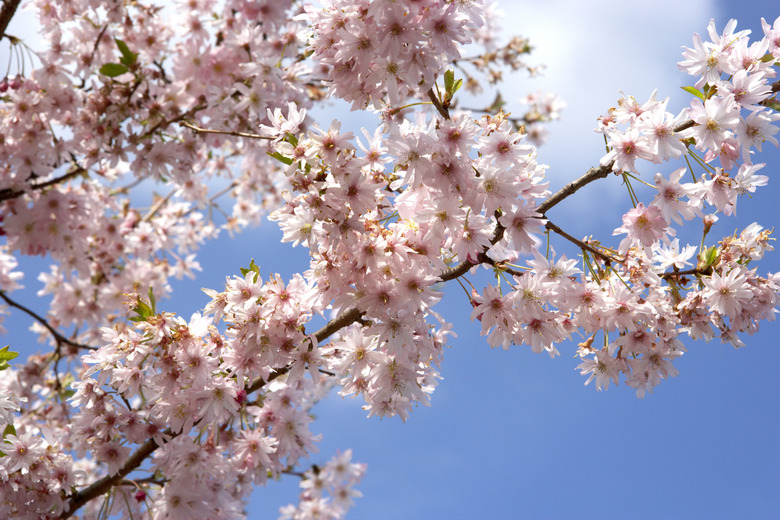How To Identify Wild Cherry Trees
The black cherry tree from the genus Prunus is also known as the wild black cherry tree. It's native to the United States and is a common sight in fields and forests in USDA plant hardiness zones 3 through 9. It's not just its dark cherries that give this tree its name; it also has a black-gray bark. By examining the leaves, flowers, fruits, twigs and bark of a tree, you can work out whether it is a black cherry tree.
TL;DR (Too Long; Didn't Read)
To identify a black cherry tree, look for simple, shiny, jagged leaves that are dark green on the top and light green on the bottom, white flowers, black fruits, black-gray bark and thin, shiny twigs.
Black Cherry Leaves
Black Cherry Leaves
Black cherry tree leaves first appear in early spring. They are simple (undivided), have jagged edges and alternate on the stem, meaning they sprout from the stem one at a time rather than in pairs. Black cherry leaves are shiny, colored dark green on the topside and light green on the underside. During fall, leaves are a combination of orange, yellow and green with an occasional pop of red.
Black Cherry Flowers
Black Cherry Flowers
You see white flowers that are about one-third inch wide on black cherry trees in mid-spring. They form 4- to 6-inch-long drooping, tubular-shaped bunches, and they may be covered in bees due to their slight fragrance. The flowers begin to bear fruit in mid-to-late summer.
Black Cherry Fruits
Black Cherry Fruits
Black cherry fruits grow in clusters of small berries. When the berries first appear, they are dark red or purple. Fruits that are not devoured by hungry birds and mammals gradually turn black. When you see a lot of birds around the tree, this is another indication the tree may be a black cherry. Birds, deer, raccoons, squirrels and black bears also eat wild cherries. The blacker the fruit, the sweeter and juicier the cherries taste.
Warning
Don't eat any part of the black cherry tree without professional advice. Its seeds, leaves and twigs are toxic.
Black Cherry Twigs and Bark
Black Cherry Twigs and Bark
Twigs on a black cherry tree are reddish-brown, thin and shiny. They have noticeable dotted lenticels, which are a woody plant's raised pores. A black cherry tree's shiny branchlets and branches are reddish-brown to reddish-gray with marked horizontal lenticels. A mature black cherry tree has dark brown-to-black bark, and it is scaly. When fully grown, a black cherry tree can reach 60 feet in height.
Cite This Article
MLA
Gillespie, Claire. "How To Identify Wild Cherry Trees" sciencing.com, https://www.sciencing.com/identify-wild-cherry-trees-6173452/. 10 April 2018.
APA
Gillespie, Claire. (2018, April 10). How To Identify Wild Cherry Trees. sciencing.com. Retrieved from https://www.sciencing.com/identify-wild-cherry-trees-6173452/
Chicago
Gillespie, Claire. How To Identify Wild Cherry Trees last modified March 24, 2022. https://www.sciencing.com/identify-wild-cherry-trees-6173452/
